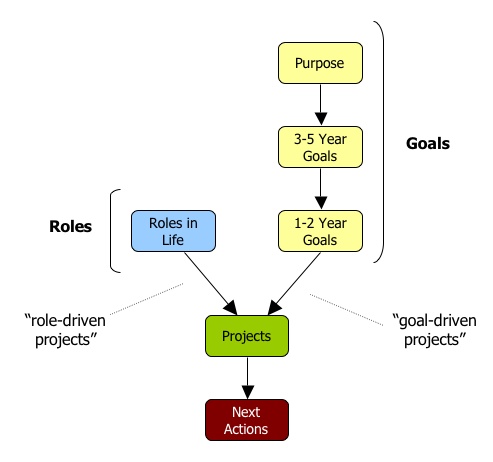Pascal Venier has been kind enough to converse with me on my recent post Reflections on GTD’s Horizons of Focus. In his first posting, Pascal concludes:
However, I would tend to consider that the main purpose of the 20,000 ft level is to help check and monitor the alignment between the areas of responsibility and the current projects: what you are doing versus what you should be doing. As such, I would tend to see it as crucial for reviewing one’s priorities and making one’s system water-tight.
I asked Pascal for an example of what he’d write down at 20,000 ft, and he graciously responded. My take-away is that a “20,000 ft” level roles and responsibilities area is helpful as a contributor to projects and thus next actions, but I believe it is in the wrong place in the “horizons of focus” model.
Let’s just back to first principles for a moment. The key reason for this horizons of focus idea is to encourage top-down planning, rather than merely licking the runway moment-by-moment. It provides us with a way of lifting our vision from the demands of the moment up to the dreams of a lifetime. And thus one way of doing this is to define purpose (50,000 ft level; which I still find helpful doing across life roles), set some long-term 3-5 year goals (40,000 ft), followed by some intermediate goals to make those more real (30,000 ft, “eat the elephant one bit at a time”), and then determine the projects (10,000 ft) and next actions (runway) that we need to do to achieve what we’ve set out to achieve. No argument from me on this one … great.
However, the thing that I dislike is that the current areas of responsibility “level” is placed between two naturally successive levels. Goals lead to projects, but in the current linear-roll down there is something else in the way. And thus I propose that the model needs to be re-drawn, in order to clearly show that goals and roles drive projects, but that goals and roles have two different pathways. Here’s a visualization of this:

You will still have current projects, but in this way of looking at it, there is much greater clarity on the lineage of specific projects and next actions. Some projects are “role-driven” whilst others are “goal-driven”. Strategic roll-down is direct and unhindered, and the other parts of our lives can be usefully embraced as a driver of projects and next actions.
What do you think? Does that help?
Categories: Culture & Competency
Reflections on GTD’s Horizons of Focus, Dec 5
I have been a long-term student of personal productivity, have purchased all the books, have tried lots of different systems. My current set up is heavily influenced by David Allen’s Getting Things Done (GTD) methodology. As I have been working
Michael,
While I agree that projects are roles and goals driven. Aren’t goals driven by roles? For example, if I have a role in my organization to drive go to market activities, I will be setting some goals specific to this role. In addition, I will set some goals for my other roles, such as family member or friend or mentor. At the end of the days, these goals break up into projects. But the goals originate from different roles in my life/work.
WDYT?
Hey Alex! Neat to have you here!
Yes, roles drive goals (and my diagram should show that somehow), but there are also some projects that we do based on roles that don’t need formally-defined goals. That’s the difference I’m trying to portray, and I think that’s the intent of David’s 20,000 ft level.
M.